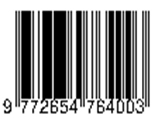THE EFFECT OF COMPOSITION GLASS FIBRE NON DENTAL AND GLASS FIBER NON DENTAL IN FIBER REINFORCED COMPOSITE TO THE STREPTOCOCCUS MUTANS BACTERIA
Abstract
E-glass fiber dental tersedia sangat terbatas di Indonesia dan mempunyai harga relatif mahal. Glass fiber non dental lebih mudah didapatkan dan harga lebih terjangkau. Glass fiber non dental umumnya digunakan sebagai bahan bangunan dan otomotif. Bakteri Streptococcus mutans mempunyai kemampuan menempel pada seluruh permukaan dalam mulut termasuk material gigi. Tujuan penelitian ini adalah mengetahui pengaruh perbedaan komposisi antara glass fiber dental dan glass fiber non dental pada fiber reinforced composite terhadap perlekatan bakteri Streptococcus mutans. Bahan yang digunakan dalam penelitian ini adalah E-glass fiber dental (Fiber-splint, Polydentia SA, Switzerland), glass fiber non dental A (LT, China), flowable komposit (CharmFil Flow, Denkist, Korea) dan silane coupling agent (Monobond S, Ivoclar Vivadent, Liechtenstein). Subjek dibagi dalam 2 kelompok, setiap kelompok terdiri dari 5 sampel. Hasil yang diperoleh dianalisis menggunakan ANAVA. Hasil penelitian menunjukkan rerata perlekatan bakteri glass fiber dental (934±7,48), glass fiber non dental (756,8±10,35). Hasil analisis statistik menunjukkan variabel komposisi memberikan pengaruh yang signifikan terhadap perlekatan bakteri(p <0,05). Kesimpulan bahwa kandungan logam alkali (Na2O dan K2O) yang pada glass fiber dapat mempengaruhi jumlah perlekatan bakteri Streptococcus mutans.
Keywords
Full Text:
PDFReferences
Jubhari, E. H., 2007, Upaya Untuk Mengurangi Preparasi Gigi : Fung Shell Bridge, Jurnal Kedokteran Gigi Dentofasial, 6 (1): 27-9
Craddock, H.L., 2009, Consequences of Tooth Loss : 1. The Patient Perspective-Aesthetic and Functional Implications. Dental Update. 36 : 616-619
Garoushi, S. dan Vallitu, P., 2006, Fiber Reinforced Composite in Fixed Partial Denture. Libyan J Med1 (1); 73-82. 4. Machmud, E., 2008, Desain preparasi gigitiruan cekat mempengaruhi kesehatan jaringan periodontal. Jurnal Kedokteran Gigi Dentofasial. 7(1):13-4.
Rius, J.R.C., 2011, Use of Fibre Reinforced Polymers in Bridge Contruction, State of the Art in Hybrid and All Composite Structures, Universitat Politecnica de Catalunya, Barcelona.
Abdulmajeed AA, Narhi TO, Vallitu PK, Lassila LV. The effect og high fiber fraction on some mechanical properties of unidirectional glass fiber-reinforced composite. Dental materials. 2011; 27 : 313-321.
Zhang, M., dan Matinlinna, J.P., 2012, EGlass Fiber Reinforced Composites in Dental Applications. Silicon.h 1-15.
Raszewski Z, Nowakowska D., 2013, Mechanical properties of hot curing acrylic resin after reinforced with different kinds of fibers. Int J of Biomedic materials Research. 1(1) : 9-13.
Alla R.K., 2013, Sajjan S, Alluri VR, Ginjupalli K, Upadhya N.2013, Influence of fiber reinforcement on the properties of denture base resins. Journal of biomaterials and nanobiotechnology, 4 : 91-97.
Sari, W.P., Sumantri, D., Imam, D. N. A., dan Sunarintyas, S., 2014, Pemeriksaan Komposisi Glass Fiber Komersial dengan Teknik X-Ray Fluoresence Spectrometer (XRF). J. B-Dent. Vol 1 (2) : 151-160.
Sideridou, I.D., dan Karabella, M.M., 2011., Sorption of Water, Ethanol or Ethanol/Water Solution by Light-Cured Dental Dimethacrylate Resins., Dental Materials., 27:1003-1010.
Kuroda S, Yokoyama D, Shinya A, Gomi H, Shinya A. 2012., Measuring the effects of water immertion conditions on the durability of fiber-reinforced hybrid composite resin using static and dynamic tests. Dental material journal. 31(3) : 449-457.
Buerger, R., Rosentrit, M., dan Handel, G., 2007, Bacterial Adhesion of Streptococcus mutans to Provisional Fixed Prosthodonthic Material, The Journal of Prosthetic Dentistry, Vol. 98 (6) : 461-9
Hauser-Gerspach, I., Kulik, E. M, Weiger, R., Decker, E., Von-Ohle, C., dan Meyer, J., 2007, Adhesion of Streptococcus Sanguinis to Dental Implant and Restorative Materials In Vitro, Dental Material Journal, 26(3): 12-16
Anggraeni, A., Yuliati, A., dan Nirwana, I., 2005, Perlekatan Koloni Streptococcus mutans pada Permukaan Resin Komposit Sinar Tampak, Maj. Ked, Gigi, (Dent. J)., 38 (1) : 8-11
Dewi, Z. Y., 2010, Efek Antibakteri dan Penghambatan Biofilm Ekstrak Sereh (Cymbopogon nardus L.) Terhadap bakteri Streptococcus mutans. Skripsi Fkg UGM.
Tahmourespour, A., Kermanshahi, R. K., Salehi, R., dan Nabinejad, a., 2008, The Relationship Between Cell Surface Hydrophobicity and Antibiotic Resistance of Streptococcal Strains Isolated From Dental Plaque and Caries, Iranian Journal of Basic Medical Sciences, Vol. 10(4) : 251-255.
Krebs, R., 2006, The History and Use of Our Earth Chemical Elements : A Reference Guide, Second Edition, Greenwood Press, Westport, Conecticut London.h 35-47.
Wang, R., Zheng, S., dan Zheng, G,, 2011, Polymer Matrix Composites and Technology. Elsevier : St.Louis, Missouri. h 17-25.
Pappas, D., Copeland, C., dan Jensen, R., 2007, Wettability Test of Polymer Films and Fabrics and Determinations of Their Surface Energy by Contact-Angle Methods, Army Research Laboratory. h 13-30.
Alkalin-Everen, B., Kulak-Ozkan, Y., Ozcan, M., dan Kadir, T., 2012, Candida albicans Adhesion on Reinforce Polymethylmethacrylate Denture Resin: Effect of Fiber Architecture and Exposure of Saliva, Gerodontology 2012, doi : 10.1111/ger. 12024, 1-8
Berkovitz, B., Moxham, B, Linden, r., dan Sloan, A., 2011, Oral Biology, Churchill Livingstone Elsevier, London. h 94-95.
Oliveira, R., Azeredo, J., Teixeira, P., dan Fonsecca, A. P., 2001, The Role of Hydrophobicity in Bacterial Adhesion, Bioline; 11-22.
DOI: https://doi.org/10.33854/JBDjbd.38
DOI (PDF): https://doi.org/10.33854/jbd.v3i1.38.g27
Refbacks
- There are currently no refbacks.
Copyright (c) 2016 B-Dent, Jurnal Kedokteran Gigi Universitas Baiturrahmah




